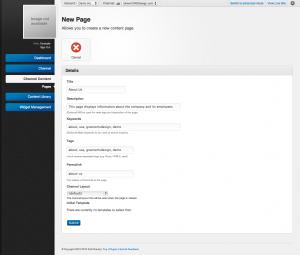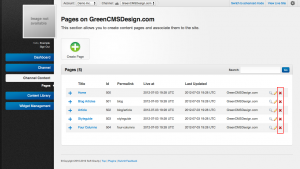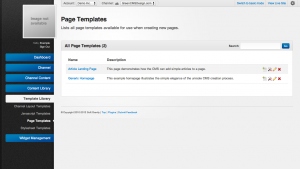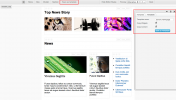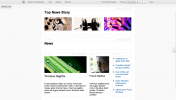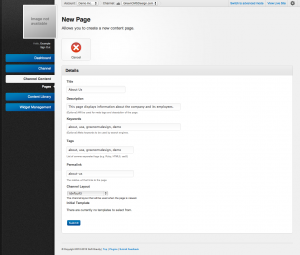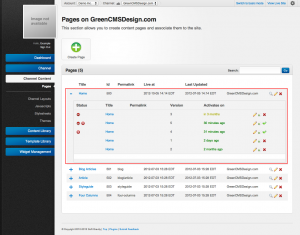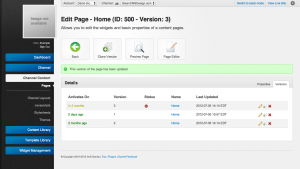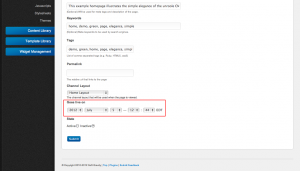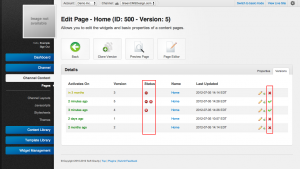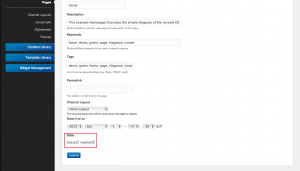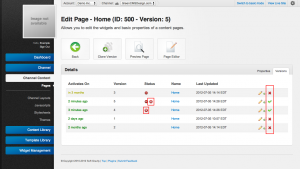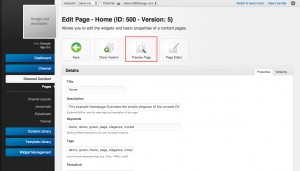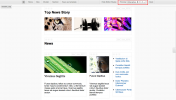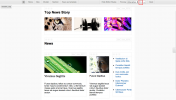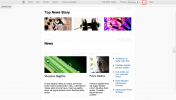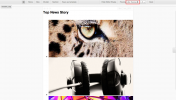Pages
| 2IE_0pNNtig | 300 | left | An introductory video to page management and usage.
}}
Pages are the backbone of unroole CMS. They are the primary user facing element used in Website Channel's and utilize many of the other elements of the CMS including Themes, Assets, Galleries, Stylesheets, JavaScripts and more. Pages utilize the powerful Layout Editor to allow users of a variety of skill levels to manipulate and layout the structure of a page. Some of the more notable features specific to pages are:
Management
Creation
Page creation is a very straight forward process and functions the same for all channels. To create a new page on a channel:
- Navigate to 'Pages' under 'Channel Content'
- Click on 'Create Page'
- Complete the mandatory fields for the page. See page meta tags for descriptions of page properties.
- Click 'Submit' to complete page creation.
Newly created pages will automatically have their 'activation date' set to the time they were created. However new pages are not immediately available to the end user giving admins the chance to edit them before going live. See page activation for steps to activate a page.
Note:
- When entering the title of a page a suggested permalink will be automatically generated for you. You can always change this permalink afterwards.
- Two pages cannot have the same permalink at any one time. See page versioning for more information.
Updates
See page versioning for more information on page updates.
Removal
Removing a page (and all its versions) is a straightforward task. To remove a page follow the instructions below.
- Navigate to the 'Pages' section under 'Channel Content'.
- Find or search for the page you wish to delete from the list.
- Click the 'Delete' icon from the action column.
- You will be prompted to confirm the page deletion. Click 'OK' to finalize the deletion.
Templates
Page templates allow you to save a page layout or design for use in another channel or at a future point in time.
- Switch to 'Advanced Mode' to see the template menu.
- Navigate 'Page Templates' in the 'Template Library'
- Click on a page template to get more information or to modify the template.
Note that since page templates are located at the Account level and not on a channel there are some limitations in the functionality they provide.
- Page templates do not use the theme or site layout queues available at the channel level.
- Previews of page templates are restricted.
- Certain references or system generated tag ids/classes will change when saving a template.
- Some widgets may loose their channel specific properties when copied into a template. These must be re-populated when build a new page from a template.
- Page templates do not employ the same versioning feature of pages. Templates will be created from whichever version of the page you were working with at the time.
Properties and Meta Tags
Each version comes with a number of properties and meta tags that can be used to customized the information displayed to browsers when a visitors views the page. Below is a list of common page meta tags and their purpose. For a list of version specific tags see page versioning.
| Property | Meta Tag | Mandatory | Description |
|---|---|---|---|
| Title | title | Yes | The name of the page which will appear in the users browser as the title of the page. |
| Description | description | Can be used to provide an overall description of the page to be read by screen readers or when scraped by search engines. | |
| Keywords | keywords | Can be used to provide a list of keywords useful for SEO when the page is scraped by search engines. | |
| Tags | Used for internal categorization of the page when searching via the admin panel. | ||
| Permalink | Yes | The path relative to the root of your derived or vanity domain setup by the channel. The permalink must be unique across all pages at any given time to prevent the system from displaying the wrong page to a visitor of the site. | |
| Channel Layout | Yes | Specifies an override of the channel layout that should be used for a specific version of the page. If left un-changed will be set to the channel default. |
It is worth noting that every property is unique per page version. This allows admins to specify different properties for other versions of the same page and create targeted meta information per version.
Versioning
Page versioning is one of the most powerful and daunting portions of the system. Unlike other systems which simply allow a user to activate a specific version ad-hoc. Unroole takes a more automated approach, giving admins full control over their content and when it is displayed. To provide this functionality, unroole page versions employ three different concepts:
To access different versions of a page you can use the following methods:
- From the page index panel
- Click the (+) icon to see the different version of a page
- Click the name of the version to jump directly to the version edit panel
- When browsing from an individual page
- Click the versions tab to see all versions
- Click the name of the version to jump to the specific version
You can also use the far right command column to edit, clone, or delete version of a page (see below for more details). When cloning a new version will always make a copy of the layout of the version that was cloned. This can be very useful in scenario's where the a previous version can be re-used with minor changes (such as a yearly Holiday promotion).
Scheduling
Page scheduling is a core components of the unroole page versioning strategy. Scheduling allows admins to configure each page version to go live at a date and time of the users choosing. These versions will automatically switch once the appropriate date and time has passed, without user intervention. This allows admins to setup an automated scheduling system for their page versions reducing human error.
Some scenarios where scheduling can be helpful:
- Updating page content on a new version and scheduling it to go live at a specific date/time.
- Creating season or event specific versions of pages months before an event
- Temporary short lived promotional pages.
- Slowly rolling out new site functionality page by page rather than all at once.
- Gracefully replacing or temporarily removing old out of date pages
Changing when a specific version of a page goes live is a fairly straightforward task.
- Navigate to the edit panel of the specific page version you wish to change.
- Change the 'Goes Live On' property to the date/time you wish this page to be visible to end users.
- Note the timezone when changing this parameter
- Click 'Submit' to change the time when the page version goes live.
'Goes live on' time can be scheduled down to one minute apart but can never have the same date/time as another version on the same page. If you wish to have two similar versions of the same page please use page templates instead to make a copy of the page.
Activation
Along with scheduling, all pages in unroole must be activated before they are visible to the end user. An active version is one that will be displayed to a visitor of the page when the scheduled date/time of that version pass. Page activation is useful in a few different scenarios:
- Preventing "live" edits when creating a new page or page version
- Quickly reverting to the previous version in cases of error
- Making the current version appear as non-existent to the end user for one-off promotions.
- Disabling the latest version of a page without entirely removing it for later use
All newly created pages and page versions start off as inactive to prevent visitors from seeing half-completed layouts. Every page version has 2 different activation concepts:
The screenshot to the right depicts page versions in a variety of different states. In the status column a disable sign indicates the current version is not active while the (x) denotes the version will be displayed as non-existant to end user. In the far right column a cross or checkmark can be used to change the existence status of the version. The following table describes, starting from the top, the state of all versions in the screenshot:
| Active/Inactive | Existence | Scheduled | Effect |
|---|---|---|---|
| inactive | future | Even when the future date passes this version of the page will not go live. | |
| inactive | removed | past | If this page was active it would act as a 404 to the end user but instead it is skipped due to its inactive status. |
| active | removed | past | This is the currently live version of the page which will return a 404 to the end user due to its existence status. |
| active | past | The previous live version of the page. | |
| active | past | Another previously live version of the page. |
Status
The activation status controls whether this page version will be considered for activation when the 'Goes Live On' date/time has passed for a specific page. This allows an admin to set a 'Go Live On' date in the past yet still make changes to the version of this page without it going live. Once the page is ready for the end-user they simply need to change its activation status to active and the page can be visible to the end user.
To change the page version active status:
- Navigate to a pages properties panel.
- Select the version of the page you wish to update from the versions tab
- Change the status from 'inactive' to 'active'
- Click 'Submit' to save the change.
Existence
The second activation control is the existence status. This status controls whether a page version appears to the end user as a normal page (HTTP 200) or as a non existent page (HTTP 404). Used in combination with Website Channel error settings this can be very useful for temporarily removing old pages or setting up short promotions that must be removed after a certain date/time.
To change the page version existence status:
- Navigate to a pages properties panel.
- Select the version tab
- Click the 'Delete' button to change the existence status to 'deleted' or 'Activate' button to re-activate a non existent page version.
Note that the existence status of a page version differs from deleting a page entirely. Pages that are removed from the page index panel are permanently destroyed.
Previewing
When making changes to a page you will often want to preview its final version to see what it will look like to the end user outside of the layout editor. Any admin with access to a page can preview it in its final state whether it's active, inactive, existent or scheduled to go live in the future. Each page version can be previewed independently and is only available to those with access to the page in the system. A preview of a page can be achieved through either a quick preview or a layout preview.
Quick Preview:
- Navigate to the page version you wish to preview
- From the properties panel click the 'Preview' icon
- You will be redirected to that version of the page with the current active channel theme applied.
Layout Preview
- Navigate to the page version you wish to preview
- From the properties panel click the 'Edit' icon
- When in the layout editor select the theme to be applied from the preview topbar item
- Apply the theme
- Click the 'in-page' (↻) preview button to refresh the theme within the layout editor
- Click the 'end user' (→) preview button to be taken to the end-user version of that page with the theme applied.
